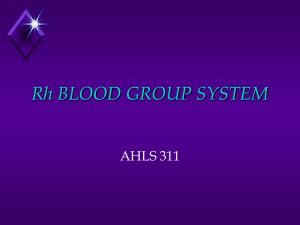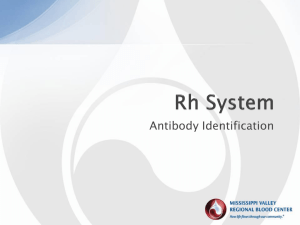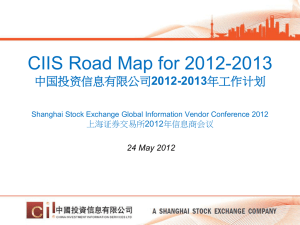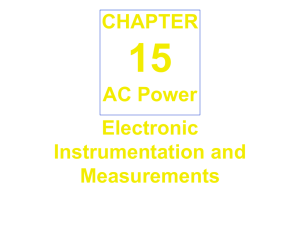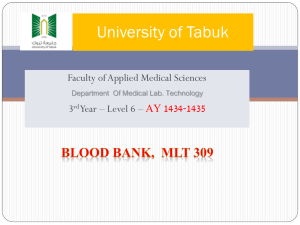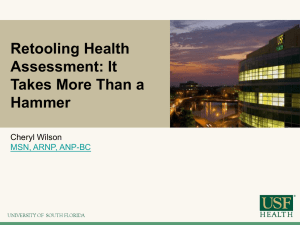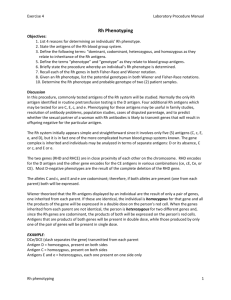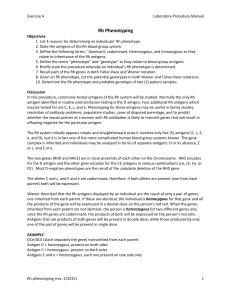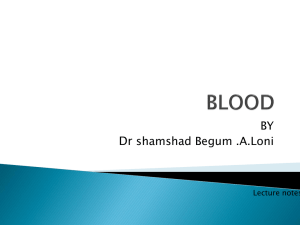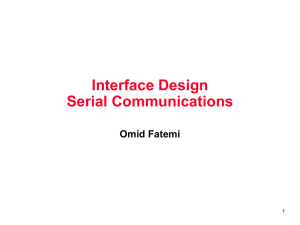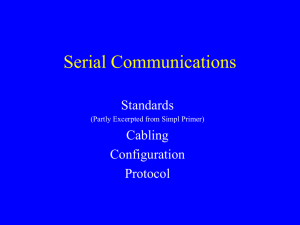ABO Blood Group - Global Healing
advertisement
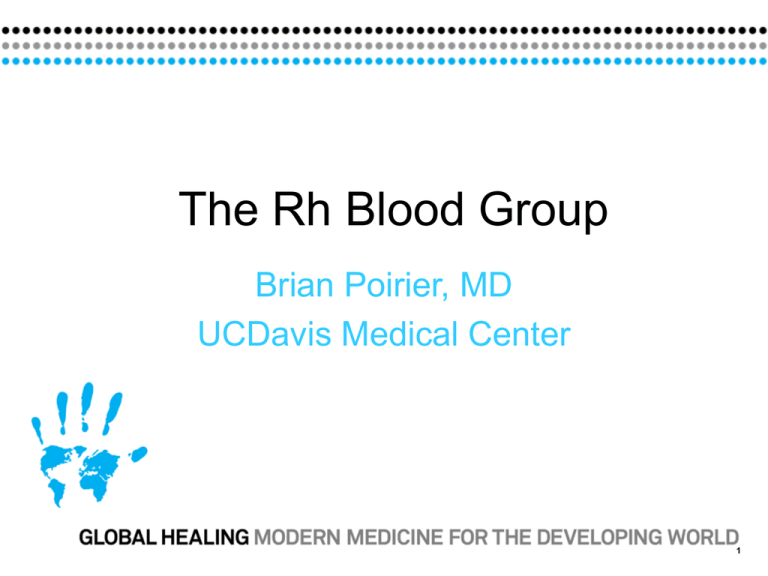
The Rh Blood Group Brian Poirier, MD UCDavis Medical Center 1 Topics • • • • Terminology systems Rh antibodies Consequences of Rh incompatibility Unusual phenotypes 2 Objectives • Explain the derivation of the term Rh • Differentiate Rh from LW • Compare and convert the major genotypes among Fisher-Race, Wiener, and Rosenfield terminologies • Define the basic biochemical structure of Rh 3 Objectives (Continued) • Describe and differentiate three mechanisms that result in weak D expression on rbcs • Describe 3 characteristics of Rh antibodies • Describe how to prevent Rh D immunization 4 5 Rh Blood Group • Second most important blood group (after ABO) 6 History of the Rh System • 1939 Levine described a HTR in an OB patient: – After delivery of a still born infant, a woman required transfusions. – After receiving her husband’s blood (ABO compatible), she demonstrated the acute HTR. – An antibody was isolated from mom’s serum that reacted both at 37 C and 20 C with father’s rbcs. 7 History of the Rh System (continued) 8 History of the Rh System (continued) • 1940 Landsteiner and Wiener reported: – An antibody made by guinea pigs and rabbits when they were transfused with rhesus monkey rbcs. – The antibody agglutinated 85% of human rbcs, was named “Rh.” – The antibody was renamed as anti-LW (Landsteiner and Wiener). – The name Rh was retained for humanproduced antibody. 9 Nomenclatures of the Rh system • • • • Fisher-Race: The DCE Terminology Wiener (Rh-Hr): The Rh-Hr Terminology Rosenfield: Alpha/Numeric Terminology ISBT (International Society of Blood Transfusion): Numeric Terminology 10 Fisher-Race (DCE or CDE) • 5 major antigens: D, C, E, c, e – Rh positive really means D positive. – Absence of D designated “d” (later found not to be a real antigen- an “amorph”). • 8 potential haplotypes named based on presence of genes for above antigens (eg, Dce, dce). 11 Wiener (Rh-Hr) • Different names for the 5 main antigens – Rho=D – rh’=C – rh”=E – hr’=c – hr”=e 12 Wiener (Rh-Hr) (continued) • Gave shorthand names to the 8 potential combinations alluded to above; still in use R1=DCe r’=dCe R2=DcE r”=dcE Ro=Dce r=dce Rz=DCE ry=dCE 13 Converting Wiener (Rh-Hr) to Fisher-Race Fisher-Race terminology is easier to use: • R=D, r=d • 1 or prime=C • 2 or double prime=E • 0 or blank=ce • any superscript letter =CE 14 Rosenfield Terminology (alpha/numeric) • Rosenfield system has no genetic basis, only demonstrates the presence or absence of the antigen on the red cells. • A minus sign preceding a number designates absence of the antigen. The absence of the number indicates the antigen has not been typed. 15 Rosenfield Terminology (Continued) • D is assigned Rh1; C is assigned Rh2; E is assigned Rh3; c is assigned Rh4; e is assigned Rh5 • Example 1: D+ C- E+ c+ e+ would be: Rh: 1, 2, 3, 4, 5 • Example 2: DCe/dcE would be: Rh: 1, 2, 3, 4, 5 16 ISBT Terminology • ISBT adopted a six-digit number for each blood goup specificiy. • First 3 numbers represent the system and the remaining 3 the antigen specificity. • 004 was assigned to the Rh blood group system; each antigen assigned to the Rh system was given a unique number to complete the 6-digit computer number. • Example: “D” antigen would be “004001” 17 “The Big Four Rh Phenotypes • R1, R2, R0, and r are most frequently encountered phenotypes. • R0 most common in blacks, least common in whites. • R 1> R 2 • r is always second in frequency • Whites: R1 > r > R2 > R0 • Blacks: R0 > r > R1 > R2 18 Gene Frequency of Rh Antigens Gene D d C E c e Frequency % 85 15 70 30 80 98 19 Common Rh Types by 3 Nomenclatures Wiener % R1r 33 R1R1 rr R1R2 11 R2r R2R2 Fisher-Race Rosenfield DCe/dce Rh: 1,2,-3, 4,5 DCe/DCe dce/dce DCe/DcE Rh: 1,2,-3, -4,5 Rh: -1,-2,-3, 4,5 Rh: 1,2,3, 4,5 18 15 DcE/dce DcE/DcE Rh: 1,-2,3, 4,5 Rh: 1,-2,3, 4,-5 9 2 20 Rh Antigens • Non-glycosylated proteins in the red cell membrane. • Inherited as codominant alleles. • Are transmembrane polypeptides and are an integral part of the red cell membrane. • All Rh antigens (D,C,E) are very similar; differ by only 44 base pair. • C and c differ in 4 a.a. • E and e differ in 1 a.a. 21 Rh Antigens Hillyer et al 2009 22 Rh Antigens (continued) • Rh antigens are highly immunogenic: D>c>E>C>e • The D antigen is the most immunogenic antigen outside the ABO system. • As little as 0.5 ml will elicit anti-D alloimmunization in healthy volunteers (Gunson et al 1970). 23 Rh Antibodies • • • • Do not bind complement Extravascular IgG Can cross placenta and cause HDFN • HTR • Exposure required (pregnancy or transfusion) 24 Consequences of Rh Incompatibility • Unexposed: 80% of healthy D negative individuals make anti-D with one unit transfused. Approximately 22% of hospitalized (non-oncology) patients (Yazer et al 2007). • Exposed: HTRs with extravascular hemolysis • Most severe HDFN 25 Prevention of D Immunization: RhIgG • Macro dose (300 g): protect against 30 mL of WB or 15 mL of packed RBCs • Micro dose (50 g): protect against 5 mL of WB; sufficient for abortion, amniocentesis, and ectopic rupture at up to 12 weeks gestation 26 27 Unusual Rh Phenotypes • Weak D phenotype Du • Rhnull phenotype • Compound Rh antigens 28 Weak D phenotype (Du) • Some D positive individuals require AHG phase to demonstrate D antigen • Reasons: – C opposite chromosome to D (C in trans position): eg, Dce/dCe – Genetic weak D (weakened D expression) – Partial D (“Mosaic”) • (most prone to making anti-D) 29 Determination of D Status • Donors: D neg donors must be confirmed by AHG test • Recipients: D neg recipients do not need to be confirmed by AHG (though most are) 30 Rh antigen typing reagents • • • • • Saline anti-D (IgM, can’t be used for Du) High protein anti-D (requiring Rh control) Chemically modified anti-D (low protein) Monoclonal anti-D Blend of Monoclonals (anti-IgM and antiIgG anti-D) 31 Rhnull Phenotype • Lacks all Rh antigens • Rhnull syndrome demonstrates a mild compensated hemolytic anemia with stomatocytosis, spherocytosis and reticulocytosis • Transfuse with Rhnull blood • The clinical symptoms of Rhmod phenotype are less severe and rarely clinically remarkable. 32 Compound Rh Antigens • f = antigen present when c and e are on the same chromosome • G: G is present on most D pos and all C pos RBCs. Anti-G originally appeared to be anti-D+C; further investigation showed that anti-G was directed toward D+G. 33 The LW System • LW antigens • Anti- LW 34 LW Antigens (normal pathway) Precursor substance DCE genes normal Rh antigens LWa LWb genes LW pos LW genes LW neg 35 Anti- LW: – Reacts strongly with most D pos rbcs. – Reacts weakly with D neg rbcs. – No reaction with Rhnull rbcs. – Reacts equally well with cord cells regardless of D typing. – Rarely clinically significant. 36 Objectives • Explain the derivation of the term Rh • Differentiate Rh from LW • Compare and convert the major genotypes among Fisher-Race, Wiener, and Rosenfield terminologies • Define the basic biochemical structure of Rh 37 Objectives (Continued) • Describe and differentiate three mechanisms that result in weak D expression on rbcs • Describe 3 characteristics of Rh antibodies • Describe how to prevent Rh D immunization 38 39 THANKS TO • Rosemary Howard, CLS • Dr Chris Gresens 40 References • Transfusion Medicine and Hemostasis, Hillyer et al, 2009, Elsevier Pub. • Yazer et al, (2007), Detection of anti-D in D- recipients transfused with D + red cells, Transfusion 47 21972201 • Avent ND, Reid (2000) The Rh blood group system: a review Blood 95 375-387. • Gunson et al (1970) The Anti-Rh0(D) Responses of Immunized Volunteers following Repeated Antigenic Stimuli, BJH 41
